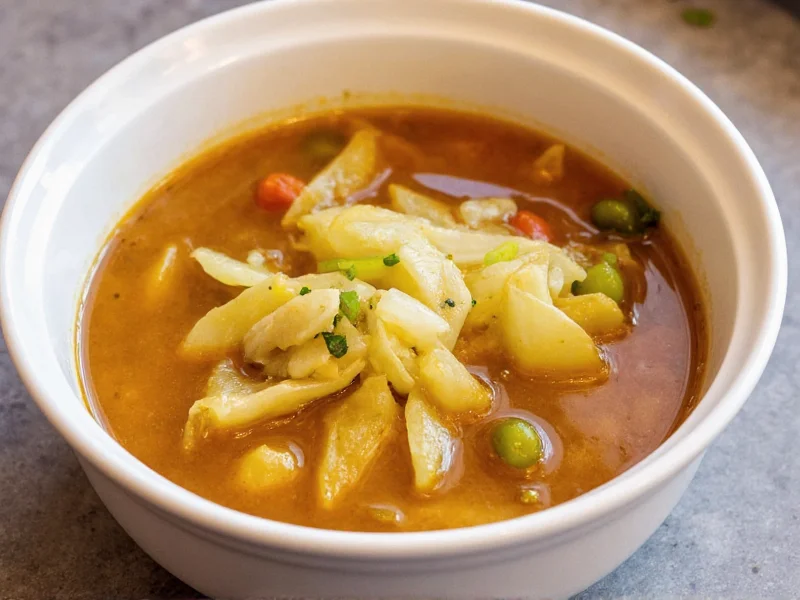Nothing beats a steaming bowl of homemade cabbage soup on a chilly day. This Eastern European staple has nourished families for generations with its perfect balance of affordability, nutrition, and comforting flavor. Our tested recipe delivers the ideal texture—neither watery nor overly thick—with layers of savory depth that surpass canned alternatives.
The Enduring Appeal of Cabbage Soup
Cabbage soup's global popularity stems from its remarkable versatility across cultures. From Polish kapuśna to Korean baechu-guk, this humble dish adapts beautifully to regional ingredients while maintaining its essential character. Modern nutrition science confirms what traditional cooks have known for centuries: cabbage contains powerful antioxidants like sulforaphane that support cellular health. The fermentation process in sauerkraut-based variations creates beneficial probiotics that aid digestion.
Essential Ingredients Breakdown
Quality ingredients make the difference between ordinary and exceptional cabbage soup. Here's what you'll need and why each component matters:
| Ingredient | Quantity | Why It Matters |
|---|---|---|
| Green cabbage | 1 small head (about 2 lbs) | Provides signature texture and mild sweetness; avoid pre-shredded for best results |
| Yellow onion | 1 medium | Creates flavor foundation; Vidalia onions add sweetness for milder version |
| Carrots | 2 medium | Adds natural sweetness and color contrast; chop uniformly for even cooking |
| Vegetable broth | 6 cups low-sodium | Quality broth makes or breaks the soup; homemade preferred but good store brands work |
Step-by-Step Preparation Guide
Follow these precise steps for foolproof cabbage soup every time. Total preparation and cooking time: 55 minutes.
- Prepare vegetables: Finely chop cabbage (about 8 cups), dice onion, slice carrots and celery into 1/4-inch pieces, mince garlic
- Sauté aromatics: Heat olive oil over medium heat, cook onion 5 minutes until translucent, add carrots and celery, cook 7 minutes
- Build flavor base: Stir in garlic, tomato paste, and herbs; cook 1 minute until fragrant
- Add liquids: Pour in diced tomatoes (with juice) and 4 cups broth, bring to gentle simmer
- Incorporate cabbage: Add shredded cabbage, remaining 2 cups broth, and bay leaf; reduce heat to low
- Simmer to perfection: Cover and cook 30-40 minutes until cabbage is tender but not mushy
- Final seasoning: Remove bay leaf, adjust salt and pepper, add lemon juice for brightness if desired
Popular Variations for Different Diets
Adapt this basic recipe to suit various dietary needs without sacrificing flavor:
- Traditional Polish style: Add 1/4 cup dried mushrooms soaked in warm water, finish with 2 tablespoons vinegar
- Keto-friendly version: Omit carrots, add 1/2 cup chopped bacon, use bone broth, include 1/2 cup heavy cream at end
- Vegan protein boost: Stir in 1 cup cooked white beans during last 10 minutes of cooking
- Quick weeknight cabbage soup: Use pre-shredded coleslaw mix, reduce simmer time to 20 minutes
Serving and Storage Recommendations
Cabbage soup tastes even better the next day as flavors meld. Follow these professional tips for optimal results:
- Serving temperature: Serve piping hot (165°F/74°C minimum) in pre-warmed bowls
- Garnish options: Fresh dill, grated Parmesan, or a drizzle of good olive oil elevate presentation
- Refrigeration: Store in airtight container for up to 5 days; the acid from tomatoes helps preserve freshness
- Freezing: Freeze portions for up to 3 months; leave 1-inch headspace for expansion
- Reheating: Warm gently over medium-low heat, stirring occasionally; add splash of broth if too thick
Troubleshooting Common Issues
Even experienced cooks encounter challenges with cabbage soup. Here's how to fix frequent problems:
- Watery soup: Simmer uncovered for additional 10-15 minutes to reduce liquid, or create a slurry with 1 tablespoon cornstarch and 2 tablespoons cold water
- Too salty: Add peeled potato chunks during last 15 minutes of cooking (they'll absorb excess salt), then remove before serving
- Bland flavor: Boost with 1 teaspoon smoked paprika, 1 tablespoon soy sauce, or a Parmesan rind during simmering
- Mushy cabbage: Add half the cabbage at beginning, remaining half during last 15 minutes of cooking
Frequently Asked Questions
Can I make cabbage soup without tomatoes?
Yes, substitute 1 cup of tomato juice with additional vegetable broth and add 1 tablespoon of lemon juice to maintain acidity balance. The soup will have a lighter flavor profile but remain delicious.
How do I prevent cabbage soup from smelling while cooking?
To minimize cooking odors, add a slice of bread to the pot while simmering, keep kitchen windows open for ventilation, and include aromatic herbs like parsley or dill which help neutralize strong smells.
What's the best way to freeze cabbage soup for meal prep?
Cool soup completely, then portion into freezer-safe containers leaving 1-inch headspace. For best results, freeze without potatoes or pasta which can become mushy. Thaw overnight in refrigerator before reheating.
Can I use red cabbage instead of green in this recipe?
Yes, red cabbage works well but will create a different color and slightly earthier flavor. Add 1 tablespoon of vinegar to help maintain the vibrant color during cooking. Cooking time remains the same.
How can I make cabbage soup more filling for a complete meal?
Add 1 cup of cooked lentils, white beans, or diced potatoes during the last 15 minutes of cooking. For protein boost, stir in shredded chicken or turkey. Serve with whole grain bread for a balanced meal.











 浙公网安备
33010002000092号
浙公网安备
33010002000092号 浙B2-20120091-4
浙B2-20120091-4